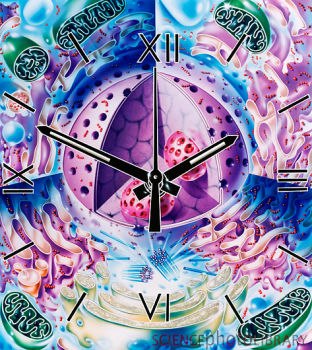
最近,一个由美国弗雷德•哈钦森癌症研究中心和德国癌症研究中心等多家机构组成的国际研究小组,共同揭示了细胞核内周期的运行机制,这一发现不仅能帮助人们理解细胞生长机制,研究如何提高或降低生长率,还有助于研究与细胞增殖异常有关的多种疾病,在农业和医学领域都具有重要意义。相关论文发表在10月30日的《自然》杂志上。
有丝分裂是一个母细胞分裂成两个子细胞,而核内周期则跳过了有丝分裂过程,细胞不断复制染色体却不分裂,从而在无脊椎动物、植物和某些人体组织中形成了很大的细胞,如肝脏细胞和肌肉。大部分植物和无脊椎动物、甲壳纲动物和软体动物的细胞也是经过核内周期发育而来。
“当细胞进入核内周期,它的DNA(脱氧核糖核酸)加倍,体积和蛋白质含量也加倍。”论文通讯作者、弗雷德•哈钦森癌症研究中心基础科学分部成员布鲁斯•埃德加说,“所以,如果能加速一种农作物或养殖贝类的细胞核内周期,就可能让它们的产量翻倍,抑制害虫的核内周期也能抑制它们的生长繁殖。”
在实验中,研究人员以果蝇为模型,通过特殊方法让它们唾液腺的细胞在核内周期复制了大约10倍,由于DNA数量增加,每个细胞体积增大了1000倍。此外,他们还研究了基因转录因子和驱动核内周期与DNA复制的酶,发现在DNA复制过程中,一种名为E2F的转录因子被一种名为CRL4的酶暂时性破坏,DNA复制完毕后E2F恢复其功能,此周期不断重复。
“E2F和CRL4共同形成一种分子振荡器。就好比一架水车,由装满水的筒和空筒共同驱动。E2F就像是水,先在一个筒中积累,而DNA复制好比是旋转的轮子,CRL4破坏了E2F的积累,就好比是把水倒空,然后重新开始这一过程。”埃德加解释说,细胞生长速度控制着E2F的积累速度,由此控制了细胞DNA复制与再复制的速度。E2F形成得越快,核内周期运转得就越快,细胞也就长得越大,而这种特性可能适用于所有生长中的细胞。
在人类细胞中,有核内周期过程的细胞不多,其中重要的如胎盘中胎儿滋养层的巨细胞,它们支持着胎儿的发育。“如果它们没有核内周期,就没有婴儿。”埃德加说,心肌细胞和某些特殊血细胞也经过核内周期形成,如果这一周期出现故障,就会导致某些疾病,要治疗这些疾病则可以瞄准构成核内周期振荡器的蛋白质。(生物探索)
相关英文论文摘要:
Control of Drosophila endocycles by E2F and CRL4CDT2
Endocycles are variant cell cycles comprised of DNA synthesis (S)- and gap (G)-phases but lacking mitosis. Such cycles facilitate post-mitotic growth in many invertebrate and plant cells, and are so ubiquitous that they may account for up to half the world’s biomass. DNA replication in endocyclingDrosophila cells is triggered by cyclin E/cyclin dependent kinase 2 (CYCE/CDK2), but this kinase must be inactivated during each G-phase to allow the assembly of pre-Replication Complexes (preRCs) for the next S-phase. How CYCE/CDK2 is periodically silenced to allow re-replication has not been established. Here, using genetic tests in parallel with computational modelling, we show that the endocycles of Drosophila are driven by a molecular oscillator in which the E2F1 transcription factor promotes CycE expression and S-phase initiation, S-phase then activates the CRL4CDT2 ubiquitin ligase, and this in turn mediates the destruction of E2F1. We propose that it is the transient loss of E2F1 during S phases that creates the window of low Cdk activity required for preRC formation. In support of this model overexpressed E2F1 accelerated endocycling, whereas a stabilized variant of E2F1 blocked endocycling by deregulating target genes, including CycE, as well as Cdk1 and mitotic cyclins. Moreover, we find that altering cell growth by changing nutrition or target of rapamycin (TOR) signalling impacts E2F1 translation, thereby making endocycle progression growth-dependent. Many of the regulatory interactions essential to this novel cell cycle oscillator are conserved in animals and plants, indicating that elements of this mechanism act in most growth-dependent cell cycles.
英文论文链接:https://www.nature.com/nature/journal/vaop/ncurrent/full/nature10579.html







